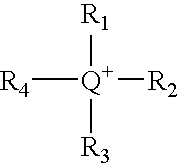Porous composite materials having micro and meso/macroporosity
a composite material and micropore technology, applied in the field of porous composite materials having micropores and meso/macroporosity, can solve the problems of preventing access to a large number of catalytic sites, difficult to recover and handle, and difficult to synthesize materials where co-catalysts are present, so as to prolong the life of catalysts
- Summary
- Abstract
- Description
- Claims
- Application Information
AI Technical Summary
Problems solved by technology
Method used
Image
Examples
Embodiment Construction
[0035] The present invention relates to the composition and synthesis of composite materials which comprise a porous crystalline inorganic oxide material having both meso- and / or macroporosity and microporosity and which also incorporate a co-catalyst in their meso- or macroporous structure. The present invention also relates to the use of such composite materials as catalysts in chemical and petrochemical processes, particularly the production of olefins from organic oxygenates, such as methanol and / or dimethyl ether, and in the direct conversion of synthesis gas (also referred to as syngas) to olefins.
Porous Crystalline Inorganic Oxide Material
[0036] The porous crystalline inorganic oxide material employed in the present composite structure comprises a first framework structure defining a first set of uniformly distributed pores having an average cross-sectional dimension of from 0.3 to less than 2 nanometers and a second framework structure defining a second set of uniformly d...
PUM
| Property | Measurement | Unit |
|---|---|---|
| size | aaaaa | aaaaa |
| diameter | aaaaa | aaaaa |
| diameter | aaaaa | aaaaa |
Abstract
Description
Claims
Application Information
 Login to View More
Login to View More - R&D
- Intellectual Property
- Life Sciences
- Materials
- Tech Scout
- Unparalleled Data Quality
- Higher Quality Content
- 60% Fewer Hallucinations
Browse by: Latest US Patents, China's latest patents, Technical Efficacy Thesaurus, Application Domain, Technology Topic, Popular Technical Reports.
© 2025 PatSnap. All rights reserved.Legal|Privacy policy|Modern Slavery Act Transparency Statement|Sitemap|About US| Contact US: help@patsnap.com

